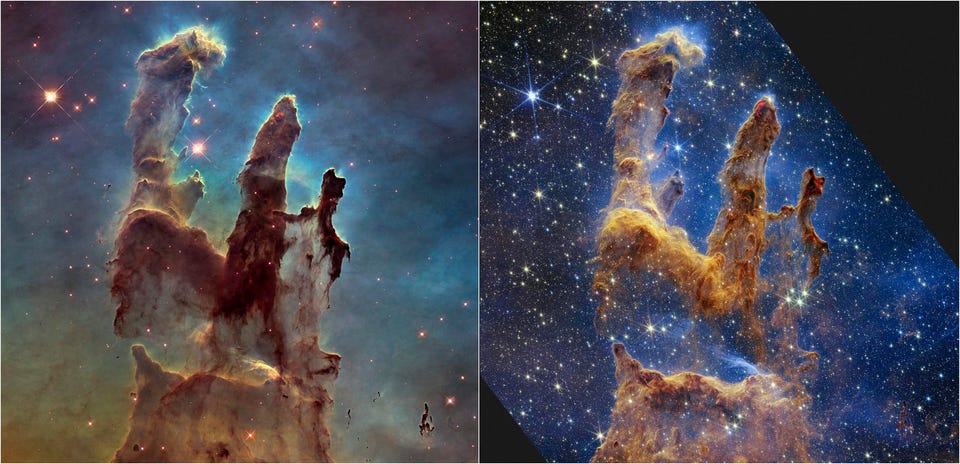Science NASA Webb Pillars Of Creation Images Offer Astronomers Much More Than Pretty Pictures Bruce Dorminey Contributor Opinions expressed by Forbes Contributors are their own. I cover aerospace, astronomy and host The Cosmic Controversy Podcast. Following New! Follow this author to stay notified about their latest stories.
Got it! Oct 29, 2022, 10:28am EDT | New! Click on the conversation bubble to join the conversation Got it! Share to Facebook Share to Twitter Share to Linkedin This combination image provided by NASA on Wednesday, Oct. 19, 2022, shows the Pillars of Creation . .
. [+] as imaged by NASA’s Hubble Space Telescope in 2014, left, and by NASA’s James Webb Telescope, right. The new, near-infrared-light view from the James Webb Space Telescope helps us peer through more of the dust in the star-forming region, according to NASA.
(NASA, ESA, CSA, STScI via AP) Associated Press NASA’s most recent James Webb Space Telescope images of the Pillars of Creation, better known to astronomers as M16 in the Eagle Nebula, are enough to leave most anyone speechless. The iconic first Hubble images of this star-forming region were so astounding at the time that they produced a cottage industry of pillar kitsch —- from calendars to coffee cups. But scientifically, the most recent images released by NASA today show a close-up view of stars in full birth mode inside these dusty towers of creation.
To most, they remain pretty pictures to marvel over. Yet for professional astronomers they offer a cornucopia of untold scientific data to pore over for years to come. Many thousands of stars have formed in these Pillars of Creation, which are actually three giant columns of cold gas bathed in the scorching ultraviolet light from a cluster of young, massive stars, says NASA.
Located in a small region of the Eagle Nebula, or M16, some 6500 light years away, the pillars, flush with gas and dust, enshroud stars that are slowly forming over many millennia, NASA notes. In the James Webb Space Telescope’s most recent images, its Mid-Infrared Instrument (MIRI), many of the newly formed stars appear missing, says NASA. That’s actually due to the fact that many of these newly-formed stars are simply no longer surrounded by enough dust to be detected in the mid-infrared spectrum, NASA notes.
That’s because massive stars weather away their birth environments of dust and gas through their emission of extreme ultraviolet radiation as well as powerful stellar winds. The fingerlike shape of the pillars is produced by expanding bubbles of gas and dust, sculpted by evaporation caused by ionizing radiation. Stellar winds and a barrage of charged particles from the central star cluster located above the pillars also ablate this region, says NASA.
MORE FOR YOU The ‘Backsies’ Billionaire: Texan Builds Second Fortune From Wreckage Of Real Estate Empire He’d Sold 50 Pounds Down And 5 Million Followers Later: A Fitness Leader That’s Helping Women Enjoy Living Room Workouts Worldwide Modeling Eastern Wisdom in Leadership Although astronomers have learned a great deal about star formation in recent decades, the mechanisms that drive the production of lower mass stars like our own G-spectral type star is still not completely understood. But with more powerful telescopes like Webb, theorists will better understand these processes. The Eagle Nebula lies several thousand light years distant and heretofore has not revealed the detail of its star formation as readily as the Orion Nebula, which lies only 1300 light years distant and is the nearest and most studied star-forming region to Earth.
Although astronomers know that the brightest and most massive stars out there are short lived, and typically live on timescales of only a few million years, most stars in the universe appear to be lower mass red dwarfs. These M-spectral type stars can continue their lives as hydrogen-burning main sequence stars for tens of billions of years. The hope among researchers is that the data that Webb is producing will enable researchers to better understand the makeup and the dynamics of the dust that lies within this iconic region of the Eagle Nebula.
Over time, we will begin to more clearly understand how stars form and burst out of these dusty clouds over millions of years, reports the European Space Agency (ESA). Because supernovae are only produced by massive stars, our own Sun most likely had its beginnings as part of a beguiling, but violent nebula that probably looked a lot like the Pillars of Creation. In essence, NASA’s Webb has given us exquisite snapshots of the kind of turmoil from which our own star must have emerged some 4.
56 billion years ago. Follow me on Twitter or LinkedIn . Check out my website or some of my other work here .
Bruce Dorminey Editorial Standards Print Reprints & Permissions.
From: forbes
URL: https://www.forbes.com/sites/brucedorminey/2022/10/29/nasa-webb-pillars-of-creation-images-offer-astronomers-much-more-than-pretty-pictures/



